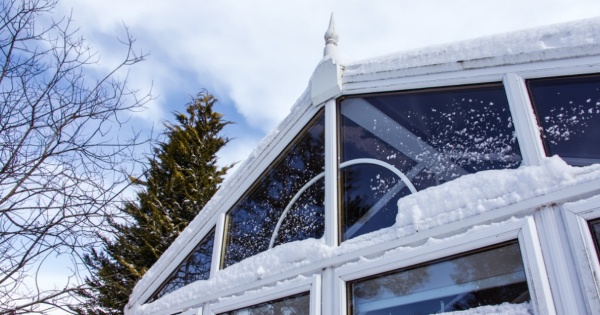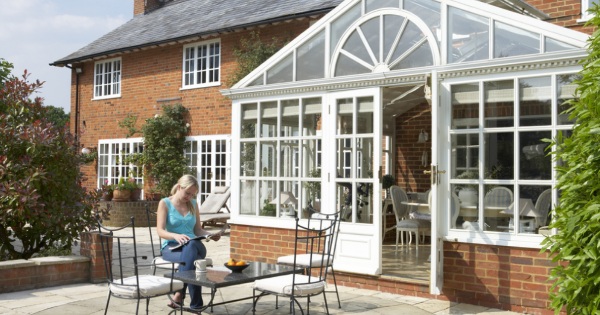Your conservatory roof shouldn’t be the cause of any issues or worries. When you think of a conservatory, you probably imagine a pleasant, comfortable garden room with a tranquil view and some kind of covering to protect you from the elements.
However, as many owners of conservatories know, it’s rarely as simple as that: wild swings in temperature, mouldy roof panes, unbearable rain noise, uncontrollable lighting conditions – the source of all of these are problems is often a glass or polycarbonate conservatory roof.
Here we’ve put together a short list of common problems that can be caused by the wrong kinds of conservatory roof, along with recommended solutions so you can start to enjoy your conservatory as it was intended.
Glass and polycarbonate conservatory roof issues
We often wonder how glass or plastic roofs ever became popular for conservatories in the UK.
With our climate of (increasingly) hot summers and cold winters, these transparent or translucent panes in your conservatory roof are likely to make this whole part of your house useless for large stretches of the year.
Let’s discuss some of the familiar problems that these roofs create:

1. Conservatories that are too hot in summer and too cold in winter
Chances are you’re not planning to use your conservatory to grow tropical plants or keep a colony of penguins. Yet experiencing extreme temperatures is probably the most frequent complaint we hear from property owners before we carry out a conservatory roof conversion.
We’ve all found ourselves happily sitting in a conservatory in July – until the sun comes out from behind a cloud. Within a few minutes the room becomes unbearably hot.
This is due to the greenhouse effect. Warm sunlight pours into the room through the panes of the glass or polycarbonate roof, but it cannot escape back out in the same way. The result is an increasingly stuffy, unregulated hothouse.
The opposite happens in winter, when heat is easily able to escape through the uninsulated panes of glass or polycarbonate roofing. . This type of roofing typically lacks the type of conservatory insulation that the rest of your house relies on to stay cosy in the colder months.
As mentioned in past posts, some try to install insulation panels on their glass or polycarbonate conservatory roof, however this excess weight can be too heavy for the current roof. This can result in an unsafe structure that does not meet building regulations. Even if the panels are not too heavy for your conservatory, their poor ventilation often results in condensation and mould — two other common conservatory complaints.
◆ Solutions for a hot or cold conservatory
You could try installing air conditioning and heaters:
An air conditioning unit will go some way to lowering the temperature during sunny summer days. Radiators or portable electric heaters in winter will also help a little.
That said, these fixes aren’t going to the root of the problem. Sunlight will still stream through the roof, and an uninsulated roof will let heated air out as quickly as a radiator can warm it.
Besides, having air conditioning and heaters on all the time is extremely wasteful for both the planet and your wallet.
Alternatively, you can adjust your clothing:
Slip a pair of shorts on, or cover up in a blanket and hat to keep comfortable in the extreme temperatures.
However, this really isn’t addressing the problem with your conservatory – just fiddling with its effects. Besides, shouldn’t your home be accommodating you, not the other way round?
How about conservatory blinds?
When the sun’s out in full you could install blinds or curtains to stop the worst effects of conservatory overheating. Unfortunately, this can be an expensive addition and won’t be a comprehensive solution.
Firstly, depending on the material used, blinds can themselves heat up and eventually radiate more heat into the room. As soft furnishings they also have a limited shelf life, so may need to be replaced every few years. Also, while they may help a bit in the summer, they don't provide significant insulation in the winter, resulting in an equally cold conservatory.
You can’t fight the elements or just put a sticking plaster on this serious issue. There’s only one solution that will allow your conservatory to be useable all-year round:
Replacing your roof with a properly insulated conservatory roof.
The Guardian Warm Roof that we install on all our conservatory roof replacement projects is the best option out there to prevent heat accumulation in the summer and to stop heat from escaping in winter.
A well-insulated roof like this has a much lower U-value than glass or polycarbonate. This is the measure of thermal transmittance – or the rate at which heat passes through a barrier, such as a roof or pane of glass.. By restricting the heat transfer through the largest surface area of the conservatory, the insulated roof prevents heat from escaping in the winter, and entering in the summer.
This means that the temperature of your conservatory will remain pleasant at all times. Plus — with this cost-saving and ecologically friendly solution you can still retain your existing windows and doors to enjoy the garden view in your conservatory.
2. Uncontrollable light conditions
Ever find yourself enjoying a great book in your conservatory and as the day wears on the diminishing light on your page-turner makes it too dark to read? Or at other times the midday sun is beaming down so strongly into your conservatory that you can’t look in one direction?
These problems are inherent with transparent conservatory roofs. When the sun is your only light source you’re a helpless victim of nature’s light conditions.
This also becomes a major problem on dark rainy days, in which you may have very little light even during the middle of the day. Seeing how frequently we get days like this in the UK, an alternative light source is a must!
◆ Solutions for a lighting problems
Blinds again
In the summer blinds can prevent the worst of the sun’s glare, but we’ve mentioned the drawbacks of installing blinds in a conservatory above. On top of which, do you really want to go round pulling down all the window covers every time the weather is nice?
Blinds also obviously don't aid in adding light on dark nights and gloomy days, so you would have to look elsewhere for proper lighting.
Light fixtures under a glass or plastic roof
While it is possible to install a central light to a glass roof conservatory, you’ll be limited to where you can put it due to the placement of the roof beams. The effect a single light source has may also be underwhelming, especially when much of the illumination escapes through the transparent roof.
Solid roof with built-in lights
A solid conservatory roof that allows for lighting fixtures to be built in wherever you like will offer the most effective solution.
Firstly, your eyes will be protected by a real ceiling when the sun is at its brightest. Secondly, artificial lighting options are almost limitless to create the perfect atmosphere and light level for any activity.
We recommend installing downward-facing LED spot lights in a solid Guardian Warm Roof. These not only give beautiful white light, but you can opt for one or more dimmer switches so you can have complete control over the intensity of each light in your conservatory.
3. Black mould in your conservatory
Another unpleasant problem in glass roof conservatories is the appearance of mould.
Mould can grow where there is a leak or imperfection between conservatory panes. The buildup of condensation on the glass or plastic is also common as temperature and humidity conditions can be highly unstable.
When moisture enters the conservatory itself this can result in black mould growing on the conservatory roof, walls or fixtures.
Black mould is particularly bad for people’s health. Known technically as stachybotrys chartarum. This fungus can cause immune and respiratory issues, allergic reactions and other nasty health problems.
Unvented solid conservatory roofs:
It's important to note that not only glass and polycarbonate roofs are susceptible to condensation and mould formation.
Many sub-par solid roofs that lack proper ventilation can also harbor condensation and mould. This occurs, because the roof will naturally sweat due to changes in temperature and humidity, and this moisture would be trapped inside the roof if it is not properly ventilated.
What are some telltale signs?
If you have a solid roof that is not properly ventilated, after about 9 to 12 months you will see a mould or fungus start to appear on the outside edge of the plasterboard. This is a very obvious sign that moisture is accumulating in your conservatory roof it has started to decompose from the inside out.
After a time, the mould will start to coming though the outside edge of the plasterboard and progress to the inside of the building.
Unfortunately, in the case of poor quality solid roofs, there is not much you can do to remove the mould without some extensive repairs, or replacing the roof all together, which why it is important to select a quality solid roof from the start.
How do I know that I am getting a high quality solid roof?
One of most obvious signs that a solid roof is of poor quality, is that the provider insists that you do not need building regulations approval or does not assist you in receiving building regulations approval.
This is due to the fact that building regulations mandate that a solid conservatory roof have proper ventilation, which is why companies providing sub-par solid conservatory roofs with inadequate ventilation will avoid seeking building regulations on purpose. Worse yet, if your conservatory roof does not comply with building regulations, and you did not seek building regulations approval, you will be financially responsable for the repairs to make your roof compliant.
◆ Solutions to black mould in a conservatory
Kill the mould
In the short term you can use bleach sprays or other chemical cleaning products to remove the spores from surfaces, but for a more permanent solution you need to address the humidity levels in the conservatory at their source.
Let air in to the conservatory
With conservatory roofing options like polycarbonate and glass roofs, the only choices you have to tackle the humidity are opening windows and doors, or buying a dehumidifier of some kind.
Conservatory roof conversion to a vented, insulated roof
A conservatory roof properly engineered to be completely weatherproof while maintaining proper ventilation will prevent black mould from forming. It will also ensure that the conservatory is never too humid, thereby tackling the root cause of mould.
The Guardian Warm Roof employs an air gap layer between insulation panels that allows humidity to escape and prevents condensation forming within the roof's structure.
4. Rain noise on a conservatory
A conservatory should be a wonderful extra space in the house that can be adapted for a variety of uses. Many people use their conservatory as an extra bedroom for instance.
However, anybody who’s ever spent a rainy night trying to sleep in a conservatory will tell you how impossible that is when there is a noisy roof.
Even during the day, holding a conversation at normal speaking volume can be difficult when raindrops are pummelling the surface of a plastic roof.
Solutions to conservatory rain noise
Short of moving your property to a climate where rain is a rare occurrence, there’s little you can do to quieten the impact of water falling on glass or polycarbonate.
Better materials and conservatory insulation
The Guardian Warm Roof comes with two kinds of finishes which are much quieter than plate glass or polycarbonate when it comes to the pitter-patter of raindrops.
The Metrotile shingles that we use are durable, attractive and protect against impacts, weather, and UV rays.
Tapco slates are another great choice, as they are lightweight, fully weather-tested, and accompanied by a 40-year warranty, it’s no wonder why they are so popular with our customers.
Both Metrotile Shingles and Tapco Slates come in a range of colours so that your conservatory roof can closely match the colour of your main roof — giving your conservatory an extension-like feel.
And with 120mm of insulation fitted into every Guardian roof between the ceiling and the tiles, there’s little chance that you’ll notice rain falling until you look out the window.
Conclusion
Traditional glass or polycarbonate roofs might have become popular in the UK for whatever reason, but if you’ve built or inherited a conservatory with a transparent roof you don’t need to live with the problems it creates.
We believe the Guardian Warm Roof installed by Projects 4 Roofing is your best option to address all the issues we’ve outlined.
If you’re considering a conservatory roof conversion we suggest taking a look at the specifications of this solid, insulated, modern conservatory roof. Not only is it a problem solver – and preventer – it’s the only model pre-approved by the LABC and is typically installed in just two or three days.
If you’re wondering how much a new roof costs or you’re eager to find out more get in touch. A Guardian Warm Roof can improve your space, and help you start using your conservatory again!



